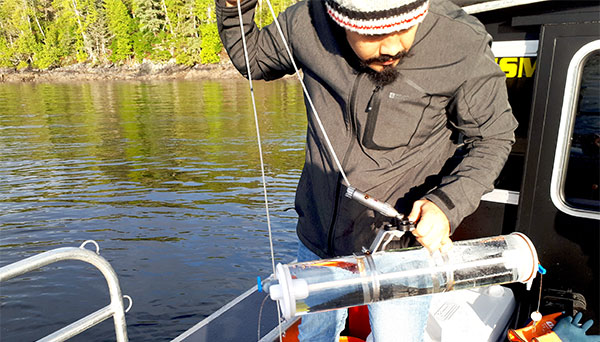Gitga’at marine food system resilience in the context of climate change
Organization: Gitga’at First Nation
Location: Gitga’at Territory
Country: Canada
Other Organizations Involved: First Nations Health Authority (FNHA), Samudra Environmental Consulting, Simon Fraser University (SFU)
 © Gitga’at First Nation
© Gitga’at First Nation
Background
The frequency and intensity of harmful algal blooms (HABs), which can cause life-threatening illnesses such as paralytic shellfish poisoning (PSP), are predicted to increase with warming ocean waters and are in fact already impacting the ability to harvest safely at key beaches in Gitaga’at territory.
The overarching goal of our pilot project is to ensure shellfish safety and to bolster food sovereignty for the Gitga’at Nation and other Coastal Indigenous peoples in times of rapid change. We see this as an important contributor to the restoration and continuity of the coupled human-nature relationships that exist through Indigenous foodways that have enabled stewardship of our territories over millennia.
Goals
- Increasing local capacity for HAB and food safety monitoring, to provide local data for adaptation planning
- Better understand the spatial patterns of HABs in Gitga’at territory to inform local adaptation and enable safe harvesting as a continuation traditional foodways
- Create long-lasting monitoring program grounded in the needs of community
- Monitor impacts of climate change to traditional food harvesting activities and consumption
- Explore interest in creating a regional Tsimshian food safety hub
Main activities
- Training Gitga’at technicians in HAB monitoring and analysis methods
- Shellfish sampling at important harvest beaches for biotoxin toxin analysis, analyzed by partner laboratory
- Water column sampling for HAB sampling, with microscopy done in community
- Research to determine spatial variability of toxicity within and across shellfish beaches and to investigate the potential of revitalizing traditional beach tending activities to impact toxicity
- Post-harvest documentation of Gitga’at knowledge-holders’ observations of change to traditional foods in territory
- Regular and ongoing communications with Gitga’at community and leadership via meetings, workshops, reports, and video updates
- Meetings with other coast Tsimshian communities to explore possibility of regional hub, and knowledge sharing with other coastal First Nations
Outcomes
- Gitga’at members trained in phytoplankton microscopy, water sampling, and data management methods
- Reports, community meetings, and scientific manuscripts communicate research and monitoring findings
- Strong foundations for ongoing community-based food safety monitoring program
- Vision and plan for collaborative development of a regional Tsimshian food security hub